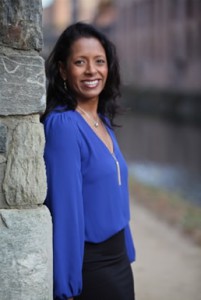An Autism Mom’s Perspective on Safety
June 01, 2016

Safety is ever present in our minds in today’s world. Violence and disasters at times surround us and make us feel even more vulnerable than we already do as parents to our special children. It seems like wherever you turn, you read or hear something about chaos in the world. Like most parents, I send my son, Dhillon, to school every day with a silent prayer that those in charge of transporting and educating him will keep him and those around him safe.
Anxiety goes hand-in-hand with the symptoms of autism for Dhillon. As a mother, I am not immune from anxiety myself. My husband, Steve, and I are his biggest role models for emotional safety. But I can’t help my son feel safe if I don’t feel safe. When we feel emotionally or physically unsafe, how do we take back our feeling of security and pass that on to our children? I do this by practicing self-care, putting my trust in others, and connecting with my “tribe.”
Just like we are taught to put on a breathing mask first on an airplane and then help others, we must take care of our own emotional and physical health as parents. Whether that means getting enough rest, exercising, or getting time for ourselves, we must take the time to fill up our cup before making ourselves available to our child and our family members.
I also teach Dhillon how to take care of himself. After years of bad experiences with the normal tantrums and aggression, he now understands that he cannot tolerate noisy or crowded environments and agrees to avoid those types of situations. We are teaching him the valuable life skills of keeping his body safe and navigating the world around him with step-by-step instructions. But demonstrating those skills across all settings is a goal that is not easily attainable for Dhillon and kids like him. As caregivers, we must take care of ourselves so that we can recognize danger around us and teach that ability to our children over time.
This is a skill that is admittedly difficult for me and, no doubt, many parents. I often say that, as a parent of a special needs child, I feel as though I live at the mercy of others’ kindness. I constantly carry a fear that my child will be hurt or bullied.
I make a habit of openly and widely sharing the fact that my child has autism. This can be met with a blank face or, sometimes, immediate understanding. I used to take for granted that everyone around me knew what the term autism means but I no longer do. After telling others about my child, I try as best as I can to model how I want them to treat him by respecting his individuality and needs.
Our children will face hurt as all kids do. I try and set up Dhillon’s friendships for success and help him process his disappointment over a negative interaction. I also talk to Dhillon about how others should treat him. I probe him about his interactions with others, and he answers to the best of his ability. We also use positive reinforcement to teach Dhillon. When he shows a valuable friendship skill, such as wishing his brother or sister good luck without prompting, we high-five him with such gusto you would think he scored the overtime game-winner in the Stanley Cup finals. My greatest wish is that one day Dhillon will make a true friend without any prompting or support from us.
To instill a feeling of safety for ourselves, Steve and I actively try to surround ourselves with people who understand or share our challenges and communities where Dhillon is accepted. Our wide network of friends who also have children with special needs and the adapted sports teams that Dhillon participates in are the two communities where I feel like we have found our “tribe.” When we are with them, I don’t feel the need to explain my child’s behavior. I can let my guard down because I am with people who “get” us and see the humor in our daily life with Dhillon. I have seen human kindness at its best from being with these friends. It gives me a true sense of hope for the future of our children when I see our society’s most vulnerable people accepted and celebrated for their gifts.
As Dhillon ages, I know that his challenges will get bigger and safety will always be a concern. I believe that we will find answers just as we are now: with trial and error. I know that my role as a parent will stay consistent in teaching him safety skills and creating awareness of autism.
I am thankful to the village of people around us who support Dhillon and help teach him these valuable life skills. Thanks to OAR as well for publishing Life Journey Through Autism: A Guide to Safety. I feel armed knowing some tips to handle the challenges yet to come. My feeling of safety has grown by practicing these strategies myself and my hope is that other parents will find some comfort too.
 Naina Narayana Chernoff is a stay-at-home mother to three children, including 9-year-old Dhillon, who has ASD, and sister-in-law to David, an adult with ASD. For the past several years, she and her family have participated in the RUN FOR AUTISM program and raised funds for OAR. Before having children, she worked as the first editor of The OARacle and also served as the editor of The Advocate, a magazine published by the Autism Society of America. She lives in Vienna, Va. along with her husband, Steven, and their children.
Naina Narayana Chernoff is a stay-at-home mother to three children, including 9-year-old Dhillon, who has ASD, and sister-in-law to David, an adult with ASD. For the past several years, she and her family have participated in the RUN FOR AUTISM program and raised funds for OAR. Before having children, she worked as the first editor of The OARacle and also served as the editor of The Advocate, a magazine published by the Autism Society of America. She lives in Vienna, Va. along with her husband, Steven, and their children.